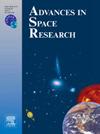CORS station for synergistic monitoring of multivariate surface parameters in expansive soils
IF 2.8
3区 地球科学
Q2 ASTRONOMY & ASTROPHYSICS
引用次数: 0
Abstract
Expansive soils cause frequent surface deformation due to their expansion and contraction, which is a serious engineering hazard, and long-term subsidence monitoring is a prerequisite for preventing and controlling expansive soil disasters. Currently, the conventional monitoring methods for the above issue include Interferometric Synthetic Aperture Radar (InSAR) technology, but InSAR is not suitable for uninterrupted monitoring of surface deformation and has low sensitivity. Meanwhile, it can’t obtain multiple surface environmental parameters around the station. The Global Navigation Satellite System (GNSS), a system that can directly acquire surface deformation, has been widely used in landslide disaster monitoring, and in recent years, this technology has also been applied to the field of expansive soil disaster monitoring. At the same time, GNSS can also provide a constant stream of L-band microwave signals to obtain ground environmental information such as precipitable rainfall and soil moisture around the station. In previous studies of expansive soil hazards, GNSS technology has been mainly used to provide surface deformation information without exploring its potential to invert ground environmental information around stations. This paper proposes a ground-based GNSS remote sensing integrated monitoring system that integrates expanding land surface parameters such as “precipitable rainfall, soil moisture, and three-dimensional deformation” and analyses the ability of ground-based GNSS to be used for integrated monitoring of expanding soil hazards by combining ten years of consecutive observational data from GNSS stations along the coastal area of Houston. The experimental results show that the GNSS is capable of providing highly accurate time-series characterization of deformation, and inelastic subsidence in recent years has resulted in a cumulative permanent elevation loss of 2 cm along the Houston coast. The correlation coefficient between soil moisture extracted by the fifth-generation European reanalysis data (ERA5) and soil moisture inverted by ground-based GNSS is 0.514. At the same time, the GNSS was also able to monitor the zenithal precipitable water vapor (PWV) and soil moisture changes around the GNSS station and further analyze the response relationship among the three parameters, which could comprehensively evaluate the stability of expansive soils, avoiding the unreliability of relying on a single piece of monitoring information to assess the stability of expansive soils. We hope to construct a more comprehensive ground-based GNSS remote sensing monitoring system to better monitor expansive soil hazards.
用于协同监测膨胀性土壤多元地表参数的 CORS 站
膨胀土因其膨胀和收缩而导致地表变形频繁,具有严重的工程危害性,长期沉降监测是防治膨胀土灾害的前提条件。目前,针对上述问题的常规监测方法包括干涉合成孔径雷达(InSAR)技术,但 InSAR 不适合对地表变形进行不间断监测,灵敏度较低。同时,它也无法获取站点周围的多种地表环境参数。全球导航卫星系统(GNSS)是一种可直接获取地表形变的系统,已广泛应用于滑坡灾害监测,近年来,该技术也被应用于膨胀土灾害监测领域。同时,全球导航卫星系统还可以提供源源不断的 L 波段微波信号,获取站点周围的降水量、土壤湿度等地面环境信息。在以往的膨胀性土壤灾害研究中,GNSS 技术主要用于提供地表形变信息,而没有挖掘其反演站点周围地面环境信息的潜力。本文提出了一种集 "可降水量、土壤水分和三维形变 "等膨胀性地表参数于一体的地基 GNSS 遥感综合监测系统,并结合休斯顿沿海地区 GNSS 观测站连续十年的观测数据,分析了地基 GNSS 用于膨胀性土壤灾害综合监测的能力。实验结果表明,全球导航卫星系统能够提供高度精确的形变时间序列特征,近年来的非弹性沉降已导致休斯顿沿海地区累计永久海拔下降 2 厘米。第五代欧洲再分析数据(ERA5)提取的土壤湿度与地基全球导航卫星系统反演的土壤湿度之间的相关系数为 0.514。同时,全球导航卫星系统还能监测全球导航卫星系统站点周围的天顶降水水汽(PWV)和土壤水分变化,并进一步分析这三个参数之间的响应关系,从而全面评估膨胀性土壤的稳定性,避免了依靠单一监测信息评估膨胀性土壤稳定性的不可靠性。我们希望构建一个更全面的地基 GNSS 遥感监测系统,以更好地监测膨胀土灾害。
本文章由计算机程序翻译,如有差异,请以英文原文为准。
求助全文
约1分钟内获得全文
求助全文
来源期刊

Advances in Space Research
地学天文-地球科学综合
CiteScore
5.20
自引率
11.50%
发文量
800
审稿时长
5.8 months
期刊介绍:
The COSPAR publication Advances in Space Research (ASR) is an open journal covering all areas of space research including: space studies of the Earth''s surface, meteorology, climate, the Earth-Moon system, planets and small bodies of the solar system, upper atmospheres, ionospheres and magnetospheres of the Earth and planets including reference atmospheres, space plasmas in the solar system, astrophysics from space, materials sciences in space, fundamental physics in space, space debris, space weather, Earth observations of space phenomena, etc.
NB: Please note that manuscripts related to life sciences as related to space are no more accepted for submission to Advances in Space Research. Such manuscripts should now be submitted to the new COSPAR Journal Life Sciences in Space Research (LSSR).
All submissions are reviewed by two scientists in the field. COSPAR is an interdisciplinary scientific organization concerned with the progress of space research on an international scale. Operating under the rules of ICSU, COSPAR ignores political considerations and considers all questions solely from the scientific viewpoint.
 求助内容:
求助内容: 应助结果提醒方式:
应助结果提醒方式:


